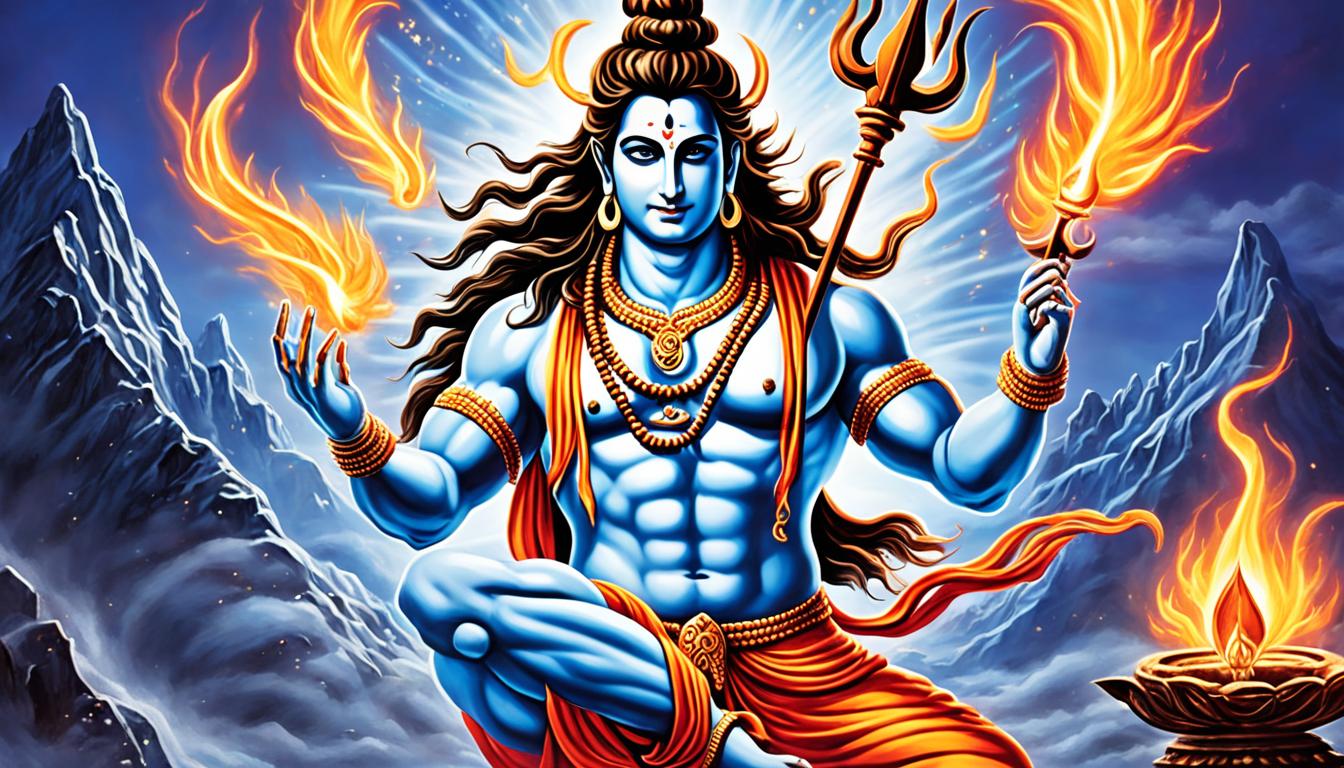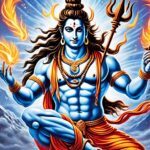Ever thought about the deep wisdom in the Shiv Puran, a top Hindu sacred book? Come with us to find the hidden truths and profound teachings. For centuries, these words have drawn people in.1
The Shiv Puran is among the eighteen great stories in Hindu mythology. It stands as a key religious text for Hindus worldwide.1 These books are crucial in Hinduism. They help people understand the universe, the meaning of life, and how to reach spiritual liberation.1
Believed to come from a divine source, the Shiv Puran sheds light on the divine universe. It also gives advice on leading a meaningful and happy life.1 By reading this and other religious texts, Hindus aim to know the divine better. They want a closer bond with the divine.1
Key Takeaways
- The Shiv Puran is a significant book in Hinduism, guiding beliefs and practices for ages.
- It helps understand the universe’s divine nature and how to achieve spiritual freedom.
- The Shiv Puran is seen as coming from a divine source. It gives advice for a good life.
- Hindus aim to know the divine more deeply by studying the Shiv Puran, seeking a closer connection.
- Its stories and teachings have deeply shaped Hindu arts and culture.
So, what special teachings is the Shiv Puran keeping? How can it change our view of the divine and our life’s spiritual journey? Join us as we dive into this exceptional book. Discover its timeless wisdom that has kept devotees fascinated for ages.1
Introduction to the Shiv Puran
The word “Shiva” means “That which is not,” pointing to nothingness as the start of all.2 Lord Shiva stands tall in Hinduism. He is the evil destroyer and universe’s protector.2 You’ll see him in forms like Nataraja, Ardhanarishvara, and Mahadev.
Definition and Significance of the Shiv Puran
The Shivalinga is key in Shiva’s worship, symbolizing universal creative energy.3 It’s thought to hold massive energy due to its unique shape. The Shiv Puran is a big deal in Hinduism. It dives into Lord Shiva’s divine nature, myths, and teachings.3 It also explains the importance of his symbols and rituals.
Historical Background and Authorship
The story behind and who wrote the Shiv Puran isn’t crystal clear. It belongs to the Puranic literature, evolving over time from both oral and written tales.3 At first, the Shiva Purana held 100,000 verses over 12 books. Now, these stories are in several versions, with the most known version having seven books.3 The oldest parts we have date back to the 10th or 11th century CE. Some later parts are likely from after the 14th century.3 Like other Puranas, the Shiva Purana changed through edits and updates.3
Lord Shiva: The Cosmic Dancer
Nataraja is the Lord of the Dance in Hinduism, showing Shiva.4 It’s a 10th-century masterpiece made during the Chola dynasty.4 Nataraja signifies Shiva’s mastery over dance and arts.4 The oldest Nataraja statue in India dates back to a Pallava King’s time in the 6th century CE.4
Symbolism of the Nataraja
Shiva in the Nataraja form performs a lively dance. He has one foot lifted and the other on the ground, with a ring of fire around him.4 This symbolizes the ongoing process of creation, preservation, and destruction in the universe.4 Shiva shows various dance styles and holds items like fire, a serpent, and a drum.4 Nataraja’s art is found in many places, such as Angkor Wat and Bali, reflecting its wide influence.4 The name Nataraja comes from Sanskrit and means “Lord of the Dance.” It symbolizes union between male and female principles in Hindu culture.4
Shiva’s Tandava: The Dance of Creation and Destruction
Shiva’s Tandava dance mixes creation and destruction. It’s full of energy and contrasts, like life and death, and light and dark.4 This dance is a key story in Shiva’s myths, highlighting his transformation power on the universe.4 Nataraja’s dance indicates the Hindu cosmology’s aspects of life, death, and rebirth.4
The Shivalinga: Embodiment of Divine Energy
The Shivalinga is an old Hindu symbol for creation’s energy and a form of Lord Shiva.5 It’s said Lord Brahma and Lord Vishnu once debated their supremacy. This led Shiva to take the form of a bright column of light before them.5 People believe the Shivalinga shape is special. It’s ideal for holding Shiva’s endless energy.5
Meaning and Mythology Behind the Shivalinga
Practices like pouring water and placing bilva leaves aim to keep the Linga’s energy strong.5 The Shivalinga holds high honor in Hinduism. It shows Shiva’s power over creating, preserving, and ending worlds.5
Rituals and Significance in Worship
In Shiva worship, the Shivalinga stands for universal creativity.5 It’s thought that the shape of every atomic reactor mirrors the Shivalinga’s form. This underlines its key role as a conduit for vast cosmic power.5 Using bilva leaves in worship is vital. It’s said to be bad luck to walk around the Shiva Linga, even in the Pradakshina ritual, as it blocks energy flow.5
Shiv Puran: Mythology and Legends

The Shiv Puran tells many stories about Lord Shiva’s birth, life, and his interactions. These tales dive into his divine nature.5
Birth of Lord Shiva
In one tale, Shiva is equated to Agni, the fire god. He was born to Prajapati and Ushas, symbolized by the Dawn.5
The Marriage of Shiva and Parvati
The marriage of Shiva and Parvati is a key legend. Parvati, Daksha’s daughter, married Shiva. This act balanced energies and is a central theme in many stories.5
The Slaying of Demons and Asuras
Shiva’s tales also include battles with demons and asuras. These stories highlight his duty to fight evil and maintain the cosmic balance.5
These myths show Shiva’s powers and also reflect on human life. They symbolize change, letting go, and the search for wisdom.5
Shiva’s Manifestations and Forms
In Hindu mythology, Shiva is shown in many forms, each reflecting his divine nature.6 For example, he appears as Ardhanarishvara, blending male and female features. This form shows the perfect union and balance of both energies.
Ardhanarishvara: The Androgynous Form
Ardhanarishvara joins manly and womanly traits.7 It teaches us the joy of balance inside ourselves. This is about unity, where opposites come together.
Mahadev: The Supreme God
Shiva’s role as Mahadev presents him as the top deity.6 In this form, he is beyond the Trimurti of Brahma, Vishnu, and Shiva.7 It shows how Shiva covers all aspects of life and mind.
The Shiv Puran looks deeply into Shiva’s various forms and what they represent.6 These forms help followers understand Shiva’s many sides. These include the fierce, the friendly, the strict, and the loving aspects of his character.
Shiv puran: Philosophical Teachings
The Shiv Puran shares deep philosophical teachings alongside its legendary stories. It delves into key Hindu concepts like karma, dharma, and moksha.5
Karma, Dharma, and Moksha
The text highlights the need to live righteously by following dharma. This is the moral code everyone should follow. It also stresses doing good deeds, like karma yoga, without wanting anything in return.5
The main aim in life, as per the Shiv Puran, is to reach moksha. Moksha means to be free from the cycle of life and death. To get there, it suggests we practice spiritual exercises, understand our true selves, and let go of our love for worldly possessions.5
Detachment and Self-Realization
Lord Shiva’s teachings focus on knowing our true selves and staying detached.5 He promotes living ethically and serving others selflessly for our own happiness and that of society.5
The Concept of Maya and Life as an Illusion
The Shiv Puran talks about Maya. Maya is the illusion that the physical world creates. It keeps us from understanding that everything is connected.5
This viewpoint means our current life is just a short phase. To be truly happy, we must see through this illusion. This journey leads us to seek spiritual growth.5
These teachings give us a way to understand life’s cycles. They show the value of living rightly and give a path to spiritual freedom. They are all seen through the Shiva’s divine perspective.5
Shiva’s Abodes and Sacred Sites

In Hindu stories, Shiva is deeply connected to special sacred places and homes. These spots are seen as filled with his divine power.8 One top place is Mount Kailash, found in the Himalayas. It’s believed to be Shiva’s heavenly abode.8 The Shiv Puran tells us Kailash is spiritually huge. It’s where Shiva lives with his wife Parvati.
The city of Varanasi is another key spot linked to Shiva. It’s known as the spiritual hub of India. And, it’s all about worshiping Shiva.8 The Shiv Puran probably talks about the huge meaning of these places. They help people connect with Shiva and receive his powerful spirit.
These holy sites are more than just places on the map. They have a lot of deep meanings in the Hindu faith. They are said to be ways to reach the gods and help believers on their path to true wisdom.8
Shiva in Art and Culture
The Shiv Puran’s stories and teachings deeply impact Hinduism’s art and culture. They inspire many images and symbols of Lord Shiva.9
Iconography and Symbolism
The Shiv Puran explains Shiva’s different forms like Nataraja, Ardhanarishvara, and Mahadev. It talks about what these forms represent.9
Depictions in Literature and Performing Arts
The Shiv Puran’s tales are also in literature, poetry, dance, and music. These art forms keep Shiva’s stories and teachings alive. They add to his importance in Hindu culture.10
This art also shares Shiv Puran’s wisdom with many. It shows how the text still influences Hindu’s spiritual and creative lives today.10
Conclusion
The Shiv Puran is a key Hindu text full of myth, baraus, and deep thoughts, all about Lord Shiva. He is a top god in Hinduism.11 It tells of Shiva´s big role in the universe, both destroying and creating. It shows us life is a circle, and we aim for wisdom and joy.11
This book has guided Hindus and influenced art and culture. From stories to dances, it’s a big part of Hindu life.11 It opens a door to Hindu ideas and stories, making it useful for those who study or follow Hinduism.11
Reading the Shiv Puran can change the way you see yourself. It hosts a sea of Hindu wisdom and shows the power of the divine in our lives.11
FAQ
What is the Shiv Puran and why is it significant in Hindu mythology?
The Shiv Puran is a crucial part of Hindu mythology, one of the eighteen Maha puranas. It shapes Hindu beliefs and practices over centuries. This text provides a way to understand the universe’s nature, life’s purpose, and the path to spiritual freedom.
What is the significance of the word “Shiva” and the divine nature of Lord Shiva?
“Shiva” means “That which is not,” showing that from nothingness comes all creation. Lord Shiva, a key god in Hinduism, is the destroyer of evil and the universe’s protector. He appears in forms like Nataraja and Ardhanarishvara.
What is the significance of the Shivalinga and its symbolic representation?
The Shivalinga symbolizes the universe’s creative energy and is thought to hold vast energy.
What are the key mythological stories and legends explored in the Shiv Puran?
The Shiv Puran shares stories on Lord Shiva’s life, including his birth and marriage. It also tells of his battles with demons.
How does the Shiv Puran depict the diverse manifestations and forms of Lord Shiva?
In the Shiv Puran, Shiva’s forms like Ardhanarishvara and Mahadev show his many aspects. This reflects Shiva’s diverse worship and understanding in Hinduism.
What are the key philosophical teachings and concepts explored in the Shiv Puran?
The Shiv Puran teaches important Hindu ideas such as karma and dharma. It stresses leading a good life and its goal of being free from rebirth.
What are the sacred sites and abodes associated with Lord Shiva in Hindu mythology?
The Shiv Puran talks about sacred places like Mount Kailash and Varanasi. These sites carry Shiva’s divine power.
How has the Shiv Puran influenced the artistic and cultural expressions of Hinduism?
This text has deeply impacted Hindu art, culture, and more. It led to a wide range of depictions of Shiva. It also influenced poetry and performing arts.
Source Links
- https://sacred-texts.com/hin/hmvp/hmvp33.htm
- https://www.jagatgururampalji.org/en/shiv-puran/
- https://en.wikipedia.org/wiki/Shiva_Purana
- https://en.wikipedia.org/wiki/Nataraja
- https://medium.com/@rahulshettigar01/life-is-a-lie-the-teachings-of-lord-shiva-on-finding-inner-truth-a31366fb050d
- https://www.britannica.com/topic/Shiva
- https://isha.sadhguru.org/mahashivratri/shiva/10-forms-of-shiva-explained/
- https://greenmesg.org/bharatavarsha/sacred_geography/shiva/
- https://www.bbc.co.uk/religion/religions/hinduism/deities/shiva.shtml
- https://isha.sadhguru.org/mahashivratri/shiva/the-shiva-purana-stories/
- https://goldcoasthindu.wordpress.com/2021/11/13/summary-of-the-shiva-purana/

